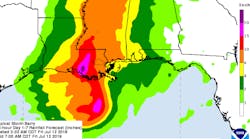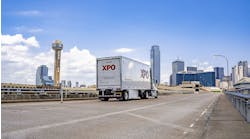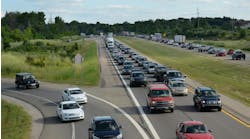By Brian K. Sullivan
(Bloomberg) — The leading edge of Tropical Storm Barry’s wind and rain are reaching Louisiana, where communities including New Orleans are bracing for a downpour that threatens to inundate already-high waterways.
As much as 25 inches of rain could fall in some areas, according to the National Hurricane Center. While the chances the storm will reach hurricane levels are fading, the moisture carried by the storm is expected to be extraordinary as it comes ashore early Saturday.
“The big thing will be the rain with this system,” said Paul Walker, a meteorologist with AccuWeather Inc. in State College, PA. “To put it in perspective, New Orleans gets about almost six inches in the month of July, they could get four times as much as they get for the entire month.”
The storm, expected to cause close to $1 billion in damage, was about 95 miles (153 kilometers) southwest of the Mississippi River’s mouth as of 7 a.m. EDT. It is moving northwest at 5 miles per hour, with current top winds of around 50 miles an hour.
Barry has already curbed about half the production of energy resources in the Gulf of Mexico, helping lift oil prices to a seven-week high.
Walker said he expects Barry to be a strong tropical storm when it makes landfall after 7 a.m. Saturday near Morgan City, about 85 miles west of New Orleans. There is still an outside chance it could become a hurricane before it comes ashore, the hurricane center said.
Ship traffic was disrupted in the Mississippi River, where water levels are rising. Companies have cut 53% of oil and 45% of natural gas output in the Gulf. Tropical-storm-force winds are reaching as far as 175 miles east of Barry’s center, according to the NHC’s advisory.
While New Orleans — where an emergency was declared Wednesday — won’t have a mandatory evacuation, residents should be prepared to shelter in place because the slow-moving storm could bring heavy rain for 48 hours, Mayor LaToya Cantrell said at a press conference. The Mississippi is now forecast to crest at 19 feet, according to the National Weather Service. That should keep the river below the tops of levees in the city, according to Cantrell.
Louisiana is already under pressure from floods after the months of rain that have set records across the U.S. and prevented farm fields from being planted. The Mississippi River in the state has been at flood stage since January and, for the first time since the Bonnet Carre spillway was completed in 1937, the Army Corps of Engineers has had to open it twice in the same year to help prevent flooding in New Orleans and take pressure off levees.
U.S. benchmark West Texas Intermediate crude traded above $60 a barrel on Friday, while natural gas futures reached the highest level in almost six weeks on Wednesday.
Gulf of Mexico operators have shut-in 1.01 million barrels a day of oil production because of the storm, the Bureau of Safety and Environmental Enforcement said in a notice. Almost 1.24 billion cubic feet a day of natural gas production is also closed.
In addition to Barry, the hurricane center is also tracking a second potential storm in the mid-Atlantic that has a 20% chance of strengthening in the next five days. That system is still “a long, long, long way away,” Walker said.
Organization: Impact
Chevron: Evacuated Petronius, Blind Faith, Genesis, Tahiti, and Big Foot platforms
BP: Evacuated Mad Dog, Atlantis, Thunder Horse and Na Kika platforms
Shell: Evacuated Mars, Ursa, Olympus and Appomattox, Auger, Salsa and Enchilada platforms; shut offshore facilities feeding Zydeco crude pipeline
Anadarko: Evacuated Constitution, Holstein, Marco Polo, Heidelberg platforms
BHP: Evacuated Neptune, Shenzi platforms
ConocoPhillips: Evacuated Magnolia platform
Exxon: Personnel evacuated from three platforms
Enbridge: Evacuating workers from Venice, Louisiana, gas facility after shutting offshore pipeline
Phillips 66: Shutting Alliance refinery in Louisiana. Full shut-down to be completed by early Friday morning
U.S. Coast Guard: Expects to set “condition Zulu” at New Orleans, meaning gale force winds within 12 hours and the port is closed
Louisiana Crescent River Port Pilots: Suspended operations
Cargill: Temporarily closing facilities in Reserve and Westwego, Louisiana
Port Fourchon: Recommends evacuation
The Gulf offshore region accounts for 16% of U.S. crude oil output and less than 3% of dry natural gas, according to the Energy Information Administration. More than 45% of U.S. refining capacity and 51% of gas processing is along the Gulf coast.
Based on its current track, the storm will likely cause about $800 million to $900 million in damage, said Chuck Watson, a disaster modeler with Enki Research in Savannah, GA. That could balloon to $3.2 billion if floods overwhelm New Orleans, he said.
A spokesman for the Army Corps of Engineers doesn’t believe levees will be topped by floodwaters. The barriers on the lower Mississippi have been inspected daily since November when flooding became an issue.
Shipping is grinding to a halt along the southern reaches of the Mississippi River as deteriorating weather conditions make it unsafe for river pilots to board and steer cargo ships. The heavy rains could hurt cotton crops in southern portions of the Mississippi Delta, said Don Keeney, a meteorologist with Maxar in Gaithersburg, Maryland. Kyle McCann, assistant to the president of the Louisiana Farm Bureau, said there hasn’t been any damage to crops in the state yet, but expects a substantial impact in coming days.
Thunderstorms have already flooded New Orleans streets and the National Weather Service has issued a flash flood watch from southern Louisiana to the Florida panhandle. City pumps had trouble keeping up with the water, which is a “bad sign,” said Enki Research’s Watson.
Additional reporting from Brian Wingfield, Shruti Date Singh, Mike Jeffers, David Marino, Jeffrey Bair, Denitsa Tsekova, Sharon Cho and Saket Sundria.



